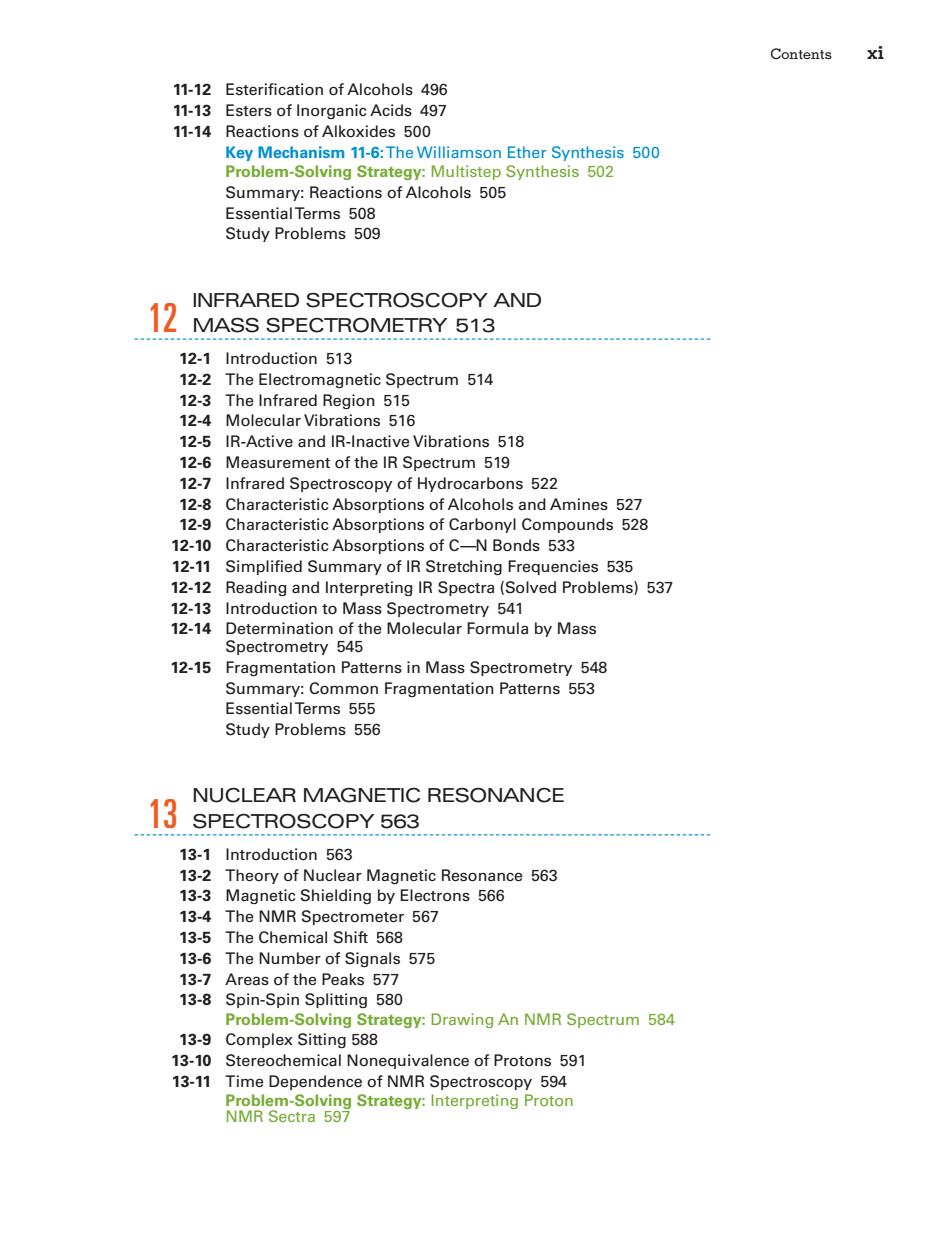正在加载图片...

Contents 女 11-12 1 497 1-14 sters of Ino ides 50 na stra ien5hersh8ge50 Summary:Reactions of Alcohols 505 EssentialTerms 508 Study Problems 509 12 INFRARED SPECTROSCOPY AND MASS SPECTROMETRY 513 12-1 Introduction 513 12-2 The Electromagnetic Spectrum 514 ar ons 51 -Activ rared Spe copy of Hyd 522 sorp cohol nd Amines 527 12.10 inds 528 ristic Ab nds 533 12.11 nplified Su of IR Stretch ing Fr 535 1212 ing and Inter 1s537 12.13 to M 5A1 12-14 Determination of the Molecular Formula by Mass Spectrometry 545 12.15 Fragmentation Patterns in Mass Spectrometry 548 Summary:Common Fragmentation Patterns 553 EssentialTerms 555 Study Problems 556 NUCLEAR MAGNETIC RESONANCE 13 SPECTROSCOPY 563 13-1 132 Introduction 563 ar Mac tic Res 13-3 Mag etic Shielding b 13-4 The NMR Spectrometer 567 13-5 The Chemical Shift 568 13.6 The Number of Signals 575 13.7 Areas of the Peaks 577 13-8 Spin-Spin Splitting 580 Problem-Solving Strategy:Drawing An NMR Spectrum 584 13-9 Complex Sitting 588 13-10 Stereochemical Nonequivalence of Protons 591 13-11 Time Dependence of NMR Spectroscopy 594Contents xi 11-12 Esterification of Alcohols 496 11-13 Esters of Inorganic Acids 497 11-14 Reactions of Alkoxides 500 Key Mechanism 11-6:The Williamson Ether Synthesis 500 Problem-Solving Strategy: Multistep Synthesis 502 Summary: Reactions of Alcohols 505 Essential Terms 508 Study Problems 509 12 INFRARED SPECTROSCOPY AND MASS SPECTROMETRY 513 12-1 Introduction 513 12-2 The Electromagnetic Spectrum 514 12-3 The Infrared Region 515 12-4 Molecular Vibrations 516 12-5 IR-Active and IR-Inactive Vibrations 518 12-6 Measurement of the IR Spectrum 519 12-7 Infrared Spectroscopy of Hydrocarbons 522 12-8 Characteristic Absorptions of Alcohols and Amines 527 12-9 Characteristic Absorptions of Carbonyl Compounds 528 12-10 Characteristic Absorptions of C—N Bonds 533 12-11 Simplified Summary of IR Stretching Frequencies 535 12-12 Reading and Interpreting IR Spectra (Solved Problems) 537 12-13 Introduction to Mass Spectrometry 541 12-14 Determination of the Molecular Formula by Mass Spectrometry 545 12-15 Fragmentation Patterns in Mass Spectrometry 548 Summary: Common Fragmentation Patterns 553 Essential Terms 555 Study Problems 556 13 NUCLEAR MAGNETIC RESONANCE SPECTROSCOPY 563 13-1 Introduction 563 13-2 Theory of Nuclear Magnetic Resonance 563 13-3 Magnetic Shielding by Electrons 566 13-4 The NMR Spectrometer 567 13-5 The Chemical Shift 568 13-6 The Number of Signals 575 13-7 Areas of the Peaks 577 13-8 Spin-Spin Splitting 580 Problem-Solving Strategy: Drawing An NMR Spectrum 584 13-9 Complex Sitting 588 13-10 Stereochemical Nonequivalence of Protons 591 13-11 Time Dependence of NMR Spectroscopy 594 Problem-Solving Strategy: Interpreting Proton NMR Sectra 597